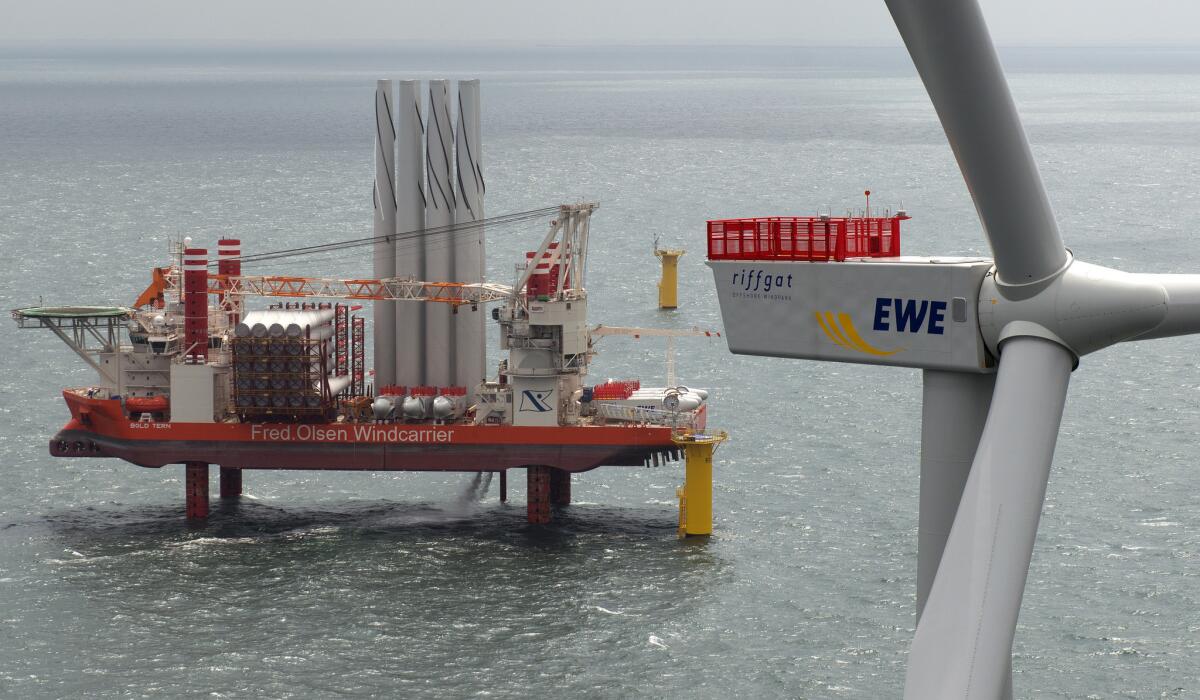California, catch the next big energy wave

- Share via
The first U.S. offshore wind turbine hooked into the U.S. power grid in June, but not in the “green” state of California. It happened on the opposite side of the continent, off the coast of Maine, using a floating wind-generator prototype well suited for the deep ocean water typically found off the coast of California.
Less than a month later, Britain inaugurated an offshore wind farm capable of powering half a million homes. Additional “blue” energy sources, including wave- and tidal-power generators and “ocean thermal energy conversion,” or OTEC, are being developed in Maine, Oregon, Scotland and China, but not in any significant way in California. Even Google, based in California, is making a major commitment to offshore wind powers but generated off the mid-Atlantic states, not here.
What’s happening? California is the state most associated with alternative energy development, yet the state’s greatest potential source of clean power (and its main geographic feature), the Pacific Ocean, is largely ignored.
GRAPHIC: Wear and tear at San Onofre
Maybe that’s because the ocean has been hands-off for energy production since the shock of the 1969 Santa Barbara oil spill, which caused Californians to fear the repercussions that ocean energy could have for the state’s beautiful shoreline and coastal economy. But though oil can foul a shoreline and overheat a planet, no beach was ever destroyed by a wind spill.
The 65-foot-tall floating wind turbine in Maine was designed by the University of Maine’s Advanced Structures and Composites Center, with support from the state and $12 million from the Department of Energy, the kind of university-based and state-supported technological innovation usually associated with the UC system. Last year, the Energy Department committed an additional $47 million to support offshore wind projects in Maine and five other states, but not in California.
The department may have felt burned in 2011, when Pacific Gas & Electric, the Northern California utility, gave up on three pilot wave-energy projects off California after spending $6 million in state and federal taxpayer funds without deploying any hardware. The company explained away the failure by saying the technology was not yet mature enough for it to invest its own money. This despite findings that California wave energy could generate 7500 megawatts a year, 3.5 times what PG&E;’s Diablo Canyon nuclear plant puts out.
VIDEO: Climate change gets its close up
Although wave energy is not as advanced as wind power, its designs, along with current, tidal and OTEC hardware, are relatively simple, along the lines of navigation buoys, barrier booms, power-plant intake pipes and bottom-fixed propeller arrays. Their commercial deployment should not be hugely expensive, and, if properly sited, neither would they overwhelm our already industrialized coast.
Of course, if wrongly sited, these systems could conflict with fishing grounds, coastal views, marine wildlife, national defense training or shipping routes, or even block standing waves and point breaks favored by surfers. That isn’t an argument against their placement but rather for the kind of ecosystem-based marine planning now being implemented as a part of President Obama’s National Ocean Policy and the West Coast Governors’ Alliance on Ocean Health.
Jerry Schubel, president and chief executive of the Aquarium of the Pacific in Long Beach, argues that the state should designate a research and development zone in the “urban ocean” off Southern California as a test-bed for competing clean energy technologies. “We could be the model,” he says. “When we use our knowledge and technology correctly, we can protect the environment and enhance the economy.”
Perhaps a logical place to launch such an effort would be at AltaSea, a 28-acre dock at the Port of Los Angeles slated — through a public/private partnership — to become a marine research center. More immediate test sites might be found along the port’s 8.5 mile breakwater or at offshore oil platforms scheduled for retirement.
California has access to innovators ready to take on ocean energy, both small companies such as Green Wave Energy of Newport Beach and larger corporations such as Science Applications International Corp. and Lockheed-Martin, which are eyeing ocean-energy projects applied to the West Coast. They say they need the state to provide some of the same financial, tax and regulatory support created by the Solar Initiative rebate program and Proposition 39, the sort of support Maine has given its offshore wind turbines. Lt. Gov. Gavin Newsom promised regulatory support at an Ocean Protection Council meeting two years ago, but words are not yet actions.
About the same time that Maine’s wind turbine began producing electricity, Southern California Edison permanently shut down the San Onofre nuclear plant. Reports suggest California could face its biggest power shortages in more than a decade this summer, with San Onofre idled and projections of low hydroelectric output. Yet the state’s 1,100-mile coastline is packed with unused sustainable energy potential. Done right, California could be leading instead of following the next wave of energy innovation that will make blue the new green.
David Helvarg is the executive director of Blue Frontier, an ocean conservation group. His latest book is “The Golden Shore: California’s Love Affair with the Sea.”
More to Read
A cure for the common opinion
Get thought-provoking perspectives with our weekly newsletter.
You may occasionally receive promotional content from the Los Angeles Times.










